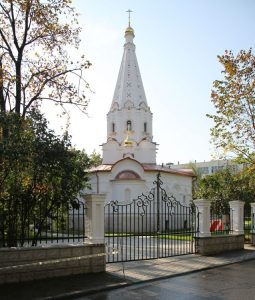Church of the Holy Prince Dimitri Donskoy in Raevo

The Church of the Holy Prince Dimitri Donskoy in Raev is located at 34, Polyarnaya street. Dmitry (Dimitri) Ivanovich was born on October 12, 1350. His parents were Ivan II the Red and Princess Alexandra Ivanovna. In 1366, Dmitry Ivanovich continued to strengthen Moscow. A new stone Kremlin was built, which saved the city a few years later. In 1368 and 1370, the great Lithuanian Prince Algirdas attempted to take the city by storm. The new walls withstood the onslaught of the enemy, and the invaders were defeated. Dmitry Ivanovich achieved the final annexation of such lands as Galich Mersky, Uglich, Beloozero, as well as Kostroma, Dmitrov, Chukhloma, Starodub principalities. In 1376, the Volga Bulgars were finally defeated. Dmitry Donskoy became the founder of the Nikolo-Ugreshsky monastery. With his help and assistance, monasteries were opened in Moscow, Serpukhov, Kolomna and other places of the Moscow Principality. The rector of the Trinity Monastery, Sergius of Radonezh, played a special role in the fate of Dmitry Donskoy. It was he who blessed the Russian army and Dmitry Ivanovich for the battle with Mamai. The strengthening of the power of the Moscow prince took place at a time when the Golden Horde itself was plagued by internal strife. Dmitry Ivanovich took the first step against the Horde and refused to pay tribute. In response, the Golden Horde attacked Nizhny Novgorod and took it by storm. But the campaign against Moscow in 1378 turned out to be unsuccessful: Mamai’s army was defeated during the Battle on the Vozha River. On September 8, 1380, a battle took place in Kulikovo Field, on the banks of the Nepryadva and Don rivers, which went down in history as the Battle of Kulikovo. The united Russian army defeated Mamai’s army. Dmitry Ivanovich took part in the battle. According to the chroniclers, he was wounded. For this victorious battle, the Grand Prince of Moscow was nicknamed Donskoy. The payment of tribute to the Golden Horde stopped for a while. The final merger of the Vladimir and Moscow principalities took place, and Moscow rightfully became the unifying center of the Russian lands. It was not possible to completely throw off the Mongol-Tatar yoke this time. Two years later, the combined forces of the Golden Horde under the leadership of Khan Tokhtamysh took Moscow. The devastation was significant, and the capital weakened again. Civil strife continued, and Dmitry Donskoy was again forced to pay tribute – however, in a more truncated amount. Despite the fact that even after the death of Dimitri Donskoy, the Golden Horde continued to raid Russia, it was his strategy of rule and his military victories that became a turning point in the centuries-old history of mutual relations with the Horde. In addition, in the era of Dimitri Donskoy, a majestic Kremlin was built in Moscow — then it was white-stone, as well as fortress monasteries — Simonov and Andronikov.
Address: Moscow, Polyarnaya str., 34B

